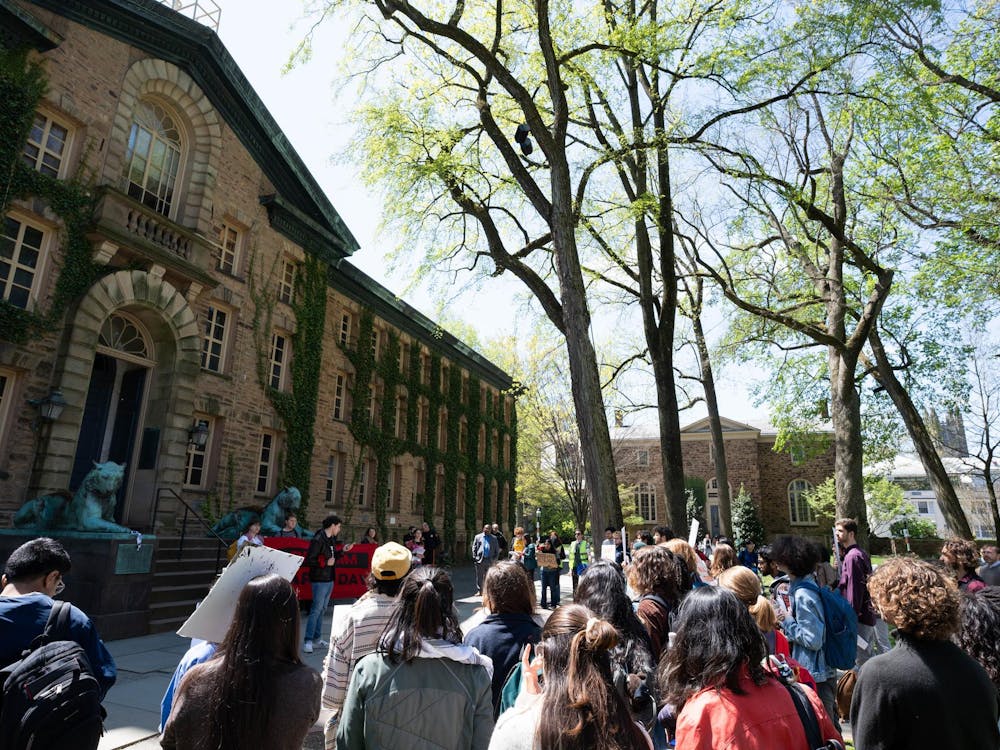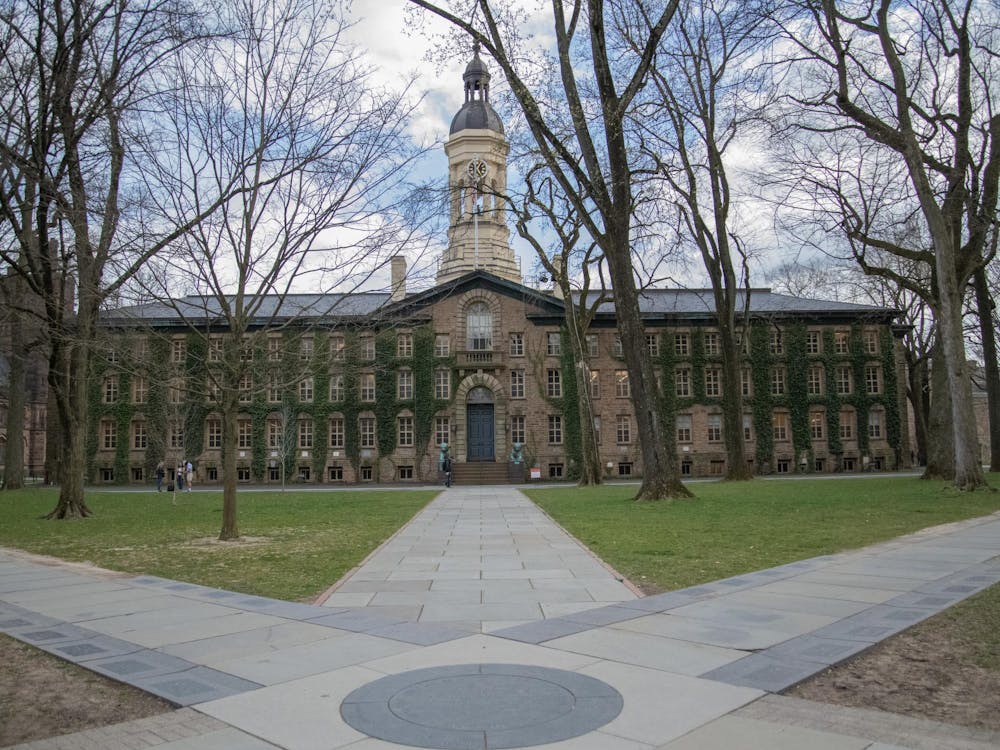There really aren’t any shortcuts on Princeton campus. For a student body whose day-to-day activity involves quite a lot of walking and biking, it seems like there’s never enough time for the trek from Frick Chemistry Laboratory to East Pyne. The new construction and renovation projects scattered around campus certainly don’t make those ten minutes between classes any easier. What many students don’t know is that these new buildings represent something that we should be proud of — the University’s commitment to sustainability.
As featured on the Sustainability at Princeton website, the Olden House, home to visiting faculty, is energy and water-efficient; the Andlinger Center for Energy and the Environment will host green roofs, rain gardens and heat recovery systems in spring 2015; and the Arts and Transit Project currently in the works will have geothermal heat pumps, biofiltration systems and daylighting control. In its goals to reduce waste and energy, the dining halls went tray-free; Café Vivian introduced a reusable container program; over 180 “Drink Local” bottle-filling stations were installed; a 5.3-megawatt solar array was established — providing about 8% of the electricity on campus last year — and the University joined the Billion Dollar Green Challenge. According to Professor of Ecology and Evolutionary Biology and Public Affairs David Wilcove,when he came to Princeton 13 years ago, “sustainability in the context of what we do on campus was barely a concern, but [the Office of Sustainability] and the University community have done an impressive job.” It’s nice to know that the University isn’t taking shortcuts in this area. While the new projects and buildings reflect an effort to “stimulate transformational thinking and exceptional performance in sustainability,” the same can’t be said for the University's endowment thus far. Despite the University’s monitoring of its on-campus ecological footprint, it has not integrated these values of environmental ethics and transparency in its investment practices, which may support environmentally irresponsible companies.
In 2011, the College Sustainability Report Card, an online evaluation of campus and endowment policies at leading institutions, published its last review of the University’s sustainability profile. The University had received an A in all categories — eight perfect scores — except for endowment transparency, in which it received a D. The survey indicated that the University neither incorporated school community feedback into proxy voting decisions nor did it give access to information on endowment holdings to the school community or general public. Instead, according to the website survey, most of these rights were reserved for the trustees, senior administrators and certain select individuals. Furthermore, donors could not choose to direct their gifts to specific investment funds, as policy states that they have to invest in the endowment as a whole. According to a Feb. 27 articlein The Daily Princetonianabout Students United for a Responsible Global Environment petitioning for divestment, University spokesperson Martin Mbugua said, “regarding specific investments, we do not discuss the specifics of our endowment portfolio in order to retain a competitive advantage in the financial market.”
The Report Card reported that “approximately one in five schools makes lists of endowment holdings available to the campus community, and in many cases, the public, [whether these lists were] kept at the investment office, sent upon request or posted on a website.” While being part of the four out of five might not seem like the gravest of sins, the University’s low rating in this category hardly upholds its values as a leading academic institution. By withholding information about how the endowment is managed and distributed, the University stifles dialogue in the college community. Considering the number of environmentally conscious student organizations on campus, the University hardly does the students a favor in excluding them from the conversation and from representation in proxy votes on investment holdings.
Since then, student bodies and faculties from across the country have been debating whether universities should divest their endowments from fossil-fuel companies. In 2013, the Princeton Association of New York City hosted a panel discussion on energy, the environment and the endowment, featuring panelists Michael Oppenheimer, professor of geosciences and international affairs, and Peter Singer, professor of bioethics. They considered relevant questions such as what divestment and its impact could mean for an institution such as Princeton that maintains a large endowment and what kinds of alternatives might exist.
A year later, a group of undergraduate and graduate students, along with faculty, staff and alumni, came together to form the Princeton Sustainable Investment Initiative. “Last September,” said Soumya Sudhakar ’18, coordinator of PSII, “400,000 people plus a large contingent of the Princeton community marched in New York City, demanding action on climate change. Basically people care about climate change and want to respond — PSII is doing just that.” PSII proposed that the University become a member of the United Nations-supported Principles for Responsible Investment, which would push the University to demand risk disclosure from the companies they invest in, encourage investors to address long-term sustainability within their portfolios and report on endowment allocation to the school community and general public. PSII also proposed that the University sign the Carbon Disclosure Project, which would further inform the University on the environmental profile of their investments and encourage these companies to steer away from practices that contributed to environmental degradation. “If elite universities divest from fossil fuels and take steps to reduce their own emissions,” Singer explained, “there is a chance that others will take notice and attitudes will change.” Perhaps the most significant of PSII’s proposal was the creation of an annual report that would track the carbon footprint of the endowment and the development of a representative committee that could oversee and guide the management of the endowment toward “a set of environmentally and financially responsible investment guidelines.”
PSII referred to two precedents in its proposal, citing the cases of South Africa and Darfur as examples in which “the University [had] taken actions that advanced far-reaching, successful movements and separated Princeton from assets that conflicted with its values.” Whether it was the campaign for divestment from apartheid South Africa in 1985, from companies associated with the genocide in Darfur in 2006 or from West Bank and Gaza in 2014, Princeton students have been on the frontlines of debate. They have established student organizations such as the Princeton Coalition for Endowment Responsibility and informational websites such as www.princetondivests.org. Beyond the maturity of staying informed and informing others, the student body has also demonstrated resourcefulness in creating effective platforms with supporters, drafting initiative proposals to present to Resources Committees and most of all, infiltrating a system that has managed to exclude many affected parties from the debate. As Archbishop Emeritus of Cape Town Desmond Tutu wrote in his June 2010 article in The World Post, “principled stands ... are essential for a better world in the making and it is always an inspiration when young people lead the way and speak truth to power.” It is therefore PSII’s mission to ensure that Princeton extends these ethics into its sustainability agenda when managing the endowment. As the proposal states, “a University that acts contrary to its values sets a model of unethical behavior before its students and the world.”
Thus far, the Initiative has been endorsed by University faculty, staff and several student organizations including Greening Dining, the Princeton Wilderness Society, Princeton Animal Welfare Society, The Princeton Progressive, SURGE and Innovation: Princeton Journal of Science and Technology. Thus far, the main concerns student organizations have had were about what it would mean to endorse the Initiative as a student group in terms of additional responsibilities in taking a public stance on a policy change. Thus far, most initiatives have involved the support of individual students, so some student organizations that have been approached wondered whether they had that responsibility as an organization to participate. However, with the diverse representation of the student body behind the Initiative, it is clear to see that it is everyone’s responsibility to care about and respond to the ethical stance that the University takes in managing the endowment, especially when this stance facilitates environmental degradation.
“What’s most important is for the University to have an open and specific set of guidelines that investors need to adhere to that takes into account the concerns of the University community,” Oppenheimer explained. “We shouldn’t be treating each investment on an ad hoc basis, in which it’s a different outcome each time and an indefensible one at that.” It therefore appears that now may be the best time for the Initiative and for students to be demanding representation and accountability from the University in the transparency of its endowment. “The campus is in the midst of its planning for the next 10 years,” said Leigh Anne Schreiver ’16, coordinator of PSII. “It seems like the perfect moment to encourage sustainability and environmental protection in every aspect of Princeton’s vision for the future.”
Isabella Gomes is an ecology and evolutionary biology major from Irvine, Calif. She can be reached at igomes@princeton.edu. Correction: Due to incorrect information provided to The Daily Princetonian, an earlier version of this article misstated the number of people who marched in the Climate March. 400,000 people marched. The ‘Prince’ regrets the error.









